🤓 The 2026 Local Search Ranking Factors are here!! Check out the report!
🤓 The 2026 Local Search Ranking Factors are here!! Check out the report!

What should a small local business website include? What pages are essential, and what kinds of content need to be featured on those pages?
The moment your small business steps onto the web, your brand becomes a publisher. You may specialize in baking cakes, building decks, or balancing accounts in the real world, but it’s your ability to promote your business on the web that will turn online searchers into customers.
This guide will teach you how to publish the perfect small local business website for your customers so that you are earning their attention, clicks, trust, transactions, repeat sales, reviews, and referrals. In addition to providing multiple real-world examples of businesses getting website publication right, this guide contains a handy checklist you can share with your team to check off that you’ve perfected the fine details of your site.
Your website exists for the use of customers. While it contains tons of information about your business, everything must be presented as an answer to the needs of your local community.
❌ What you don’t want: to have your brand come off like a self-absorbed person, boasting about yourself.
✅ What you do want: to publish a website that’s the next best thing to a real-world customer service star on your staff, who is eager to greet and converse with everyone who comes in the door, and to help them find exactly what they need.
Before you begin building your small local business website, resolving to build it for customers is one of the smartest marketing decisions you’ll ever make.
With this as your mindset, let’s walk step-by-step through the process of developing a major digital asset for your small business.
Before you can give customers what they want, you need to know:
When it comes to searches with a local intent (like restaurants near me, dentist San Jose, or women’s shoes downtown) there is no such thing as being the #1 in Google’s results.
Google local pack results like this:

And their organic results look like this:

Google customizes both types of results based on the location of the searcher at the time they search. You can see this phenomenon in action by doing a search while at your place of business and then going across town to do the same search. Unless the geographic market you’re in has little or no competition, you’ll see Google bring up different results based on the fact that you changed the location of your device when you went across town.
To start getting a sense of your market, go to Google.com/maps and look up the name of your city.
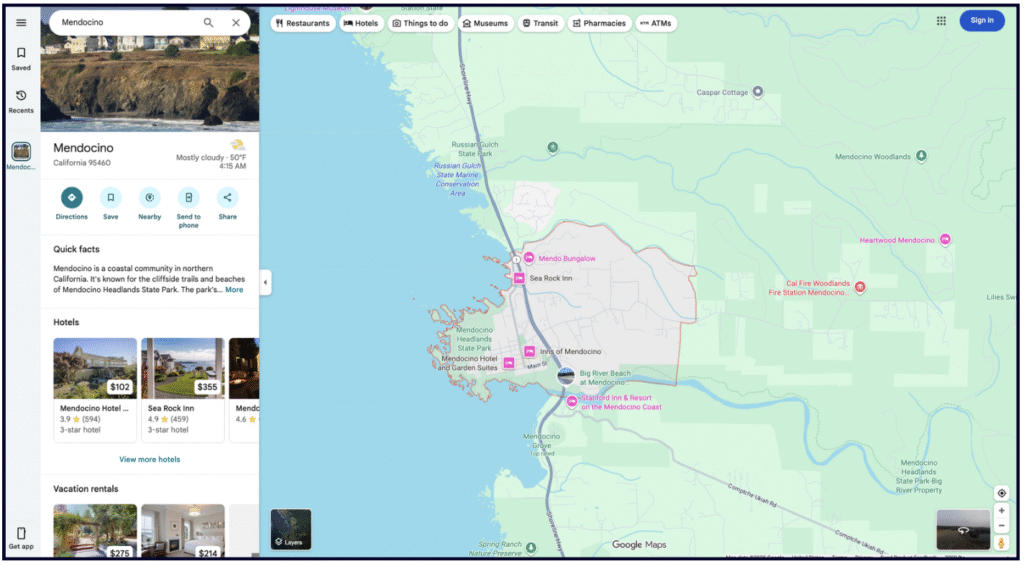
The red dotted border Google draws around your city’s perimeters is something you need to see. If the address of your business falls within that perimeter, then there will typically be nothing standing in your way of achieving high visibility in Google’s local and organic results for searchers located in that city or who include the name of the city in their searches. You’ll be on an equal footing with competitors who are also within the borders, at least in terms of location.
However, for some searches, Google may draw a very tight radius. For example, a doctor located in a doctors’ park where many of a city’s medical facilities are located may be at a ranking advantage over one who is not in that center (sometimes referred to as a “centroid”). In other cases, being too close to competitors who share your GBP categories can actually have the opposite effect, causing Google to filter out the weaker competitor at the automatic zoom level of Maps. Location is just one ranking signal, and you’ll need to build up multiple metrics to become the most visible competitor in your town.
❗ If your address falls outside your community’s border, it’s important to know that you will be at a ranking disadvantage unless you have little or no competition in your market.
At this point, you can choose to move forward, knowing that Google will be less likely to bring you up as a result for customers inside the border or who specify the city name in their search language, or you might decide you need to move to a better address before developing your website.
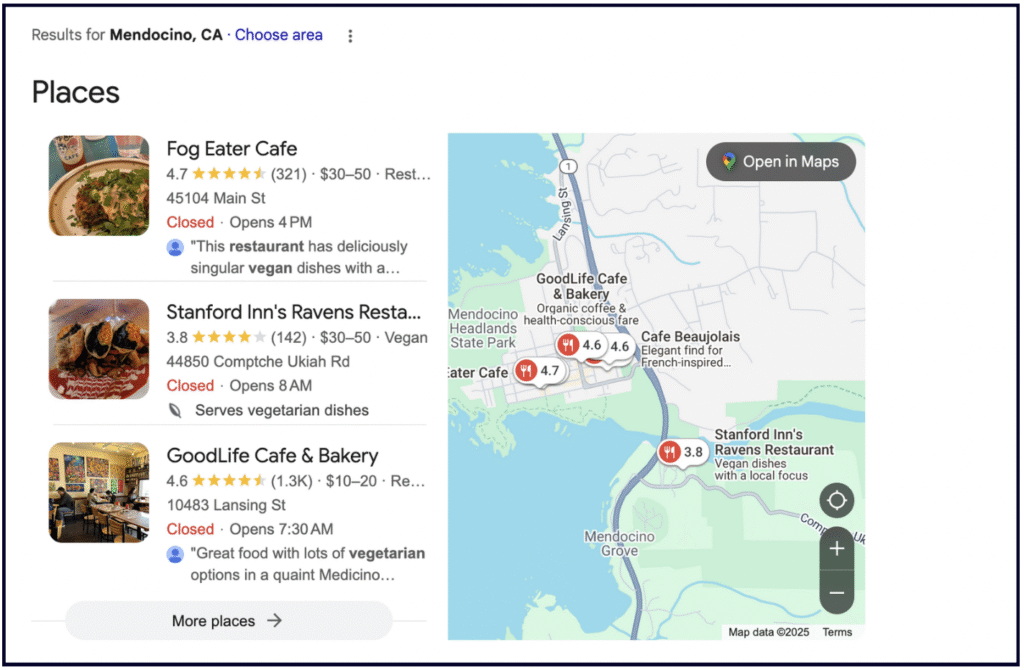
Next, take a guess at the main search term someone in your community would type into Google when looking for a business like yours. This could be a very broad phrase, like restaurant in Mendocino, or, if your business is somewhat more specialized, a more refined phrase like vegetarian restaurant Mendocino (shown above). While located at your place of business, do this search in Google.
The set of three results Google typically brings up for local-intent searches of this kind is called a “Local Pack”. Most of the information that appears in local packs stems from Google’s version of local business listings, which are called “Google Business Profiles” (GBPs). Once your website is published, you’ll want to create your own GBP, but for now, take note of your top competitor in the local pack. By clicking on their listing, and then clicking on the “website” link on their Google Business Profile, you’ll be taken to their site for a quick study of how good of a job your top competitor is doing as a publisher.
Does your top competitor’s business name contain any of the words in your search phrase? In this example, our top competitor, “Fog Eater Cafe”, doesn’t have the words “vegetarian”, “restaurant” or “mendocino” in their business name.
Google is biased towards showing local pack results that have business names that match search phrases as closely as possible. You could have a competitive advantage if your business is named something like “Happy Family Vegetarian Restaurant”, or “Simon’s Mendocino Restaurant By The Sea”.
If your business name doesn’t contain any of your core search queries, you might want to consider getting a legal DBA before developing your website.
Note whether your competitor’s address is centrally located in the market segment you are trying to reach. As mentioned above, you have the best chance of ranking well in Google’s local and organic results for the customers nearest you. If your competitor’s street address is quite near yours, then your proximity to the same segment of local customers is about equal.
If, however, your competitor is across town, then you may be able to seize a ranking advantage by being closer to the customers nearest you as you build up the strength of your website and Google Business Profile.
Sometimes also called the Unique Sales Proposition (USP), a UVP is a short statement that summarizes the core identity and offering of the business. Here are some fictitious examples of UVPs you might encounter on competitors’ home pages, about pages, mission statement pages, and other parts of their websites:
✍️ A strong local business website never assumes that incoming customers (or the search engine bots that will crawl the site) already know what a brand does or where it is located. Look at any UVP published on your competitor’s website to understand how your business can both present and differentiate itself in the community.

To see your competitor’s title tags, mouse over the browser tabs at the top of your competitor’s website pages. In this case, we can see that the competitor has made an effort to optimize their homepage’s title tag like this:
Fog Eater Cafe | Mendocino, California | Vegetarian Restaurant
The title tag is an element you can typically customize for each page you publish via your website builder software, and though Google can further customize what they present in their organic results for any page, we can see here that the organic result for this particular competitor looks like this:
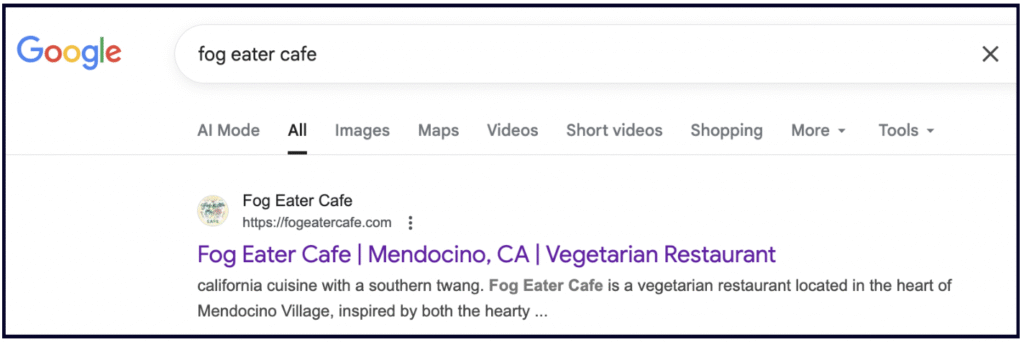
At a glance, we can see that this competitor who is ranking at the top of Google’s local packs for our original search term, vegetarian restaurant mendocino, is making an effort to optimize their title tags for this phrase, and it could well be assisting their local pack and organic rankings.
Document the terms you see your competitor emphasizing in their title tags. These may be terms you’ll want to use on your website, too.
Make note of the pages your competitor has published. Which topics have they devoted a unique page to? Are there keywords in the main headings and subheadings on the text content of these pages? Are there keywords in the URLs (i.e. website page addresses) for each of these pages? Are the pages text only, or has an investment been made in a multimedia approach including photos and videos? How well does the content read to you? Does it seem professional and trustworthy, or is it full of errors and typos? Does it answer your questions, or do you feel unclear about what the business is and what it offers?
Study what your competitor has done as a publisher to begin to get ideas for your own site, and to start to strategize how you can do better.
Has your competitor abundantly published all forms of contact information on their site, or have they made a halfhearted effort with this core content? A strong competitor will not only have their complete and accurate name, address, and phone number in highly visible areas of their site, but will also have hours of operation, SMS/text lines, email, forms, booking functionality (if appropriate), and links to their review and social media profiles.
A strong competitor’s website will contain a clear call-to-action on every page so that the customer knows which steps are available to take next. CTAs could include calling the business, booking an appointment, clicking to another page on the site, filling out a form, emailing the business, texting the business, reviewing the business, purchasing something from the business (if e-commerce is present), or visiting the business in person.
Imagine yourself as a random potential customer – make a judgement about whether your top competitor’s website is helpful, easy to use, and provides a good experience that assists you in doing whatever you might want to do on their site. If the experience is confusing or difficult, you can create a competitive advantage by building a better website.

In addition to identifying your top competitor in Google’s local pack for your core search phrase, look at the organic results for the same term. In this case, our example restaurant has earned both the top local and organic ranking, but this isn’t always the case. If your top organic competitor is different from your top local pack competitor, study both to get ideas for your website.
The goal of this step is to discover:
Most businesses start out with a core set of products and services they plan to offer to the public. For example, a locally-owned grocery store will stock basic staples and a marriage and family therapist will offer couples counseling.
Competitive differentiation lies in uncovering additional goods, services, amenities, features, and other offerings that the local public wants but isn’t easily accessing in their community. The grocer might discover that no one else in town is stocking a beverage people are reminiscing about online and the therapist could learn that there’s a lack of affordable group therapy options in their town.
Your options for finding out what local people want include:
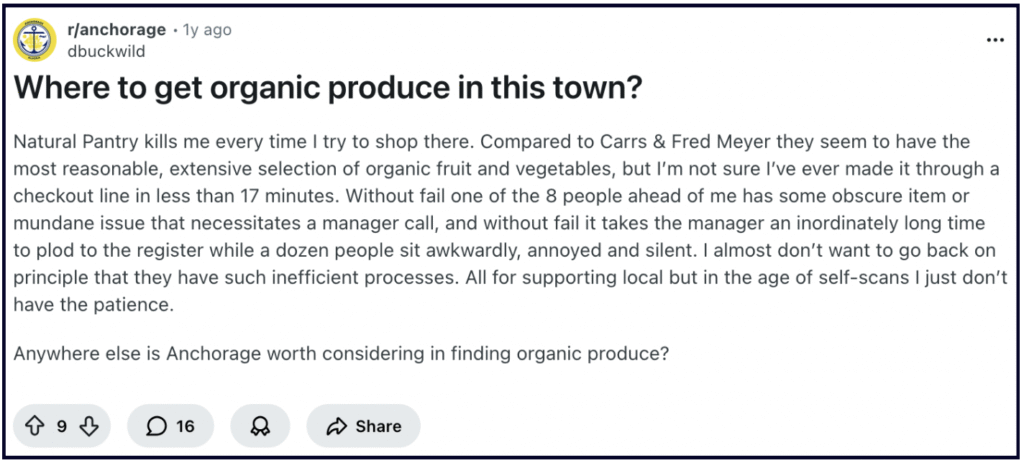
A single thread like this one from Reddit in which people in Anchorage are asking questions, voicing dissatisfaction, and offering one another suggestions could be a boon to any grocer in that city who is willing to listen and brainstorm solutions to fulfil an unmet consumer demand.
It’s often the case that consumers do have options for particular goods and services in their town, but they simply aren’t happy with what’s available. Social media is a good starting point for finding out how a community feels about its local commercial landscape, but the best way to get detailed sentiment is to return to the Google Business Profile of your top competitor and look at their reviews.
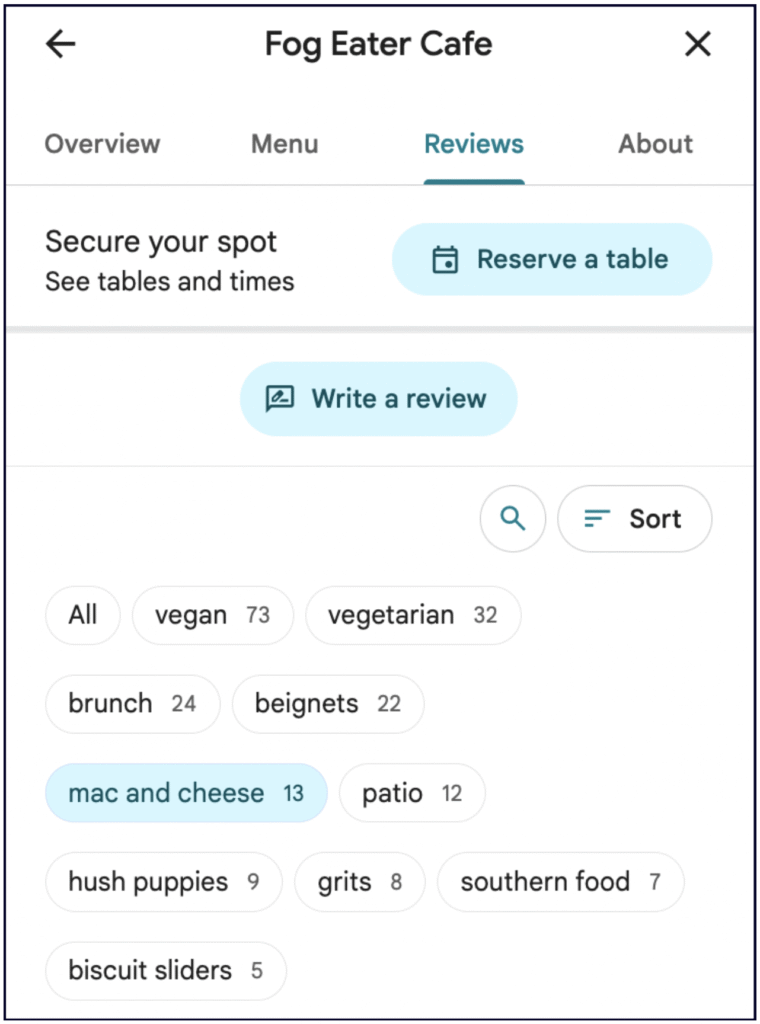
Look at the competitor’s overall star rating, which you’ll need to match and surpass, and then look at the set of tabs underneath it. These are called Place Topics, and they highlight frequently-mentioned topics in your competitor’s reviews. Click on these tabs to discover whether the mentions of each topic are mainly positive or if negative sentiment indicates that the competitor is not doing a good job, meaning you have an opportunity to offer a better experience.
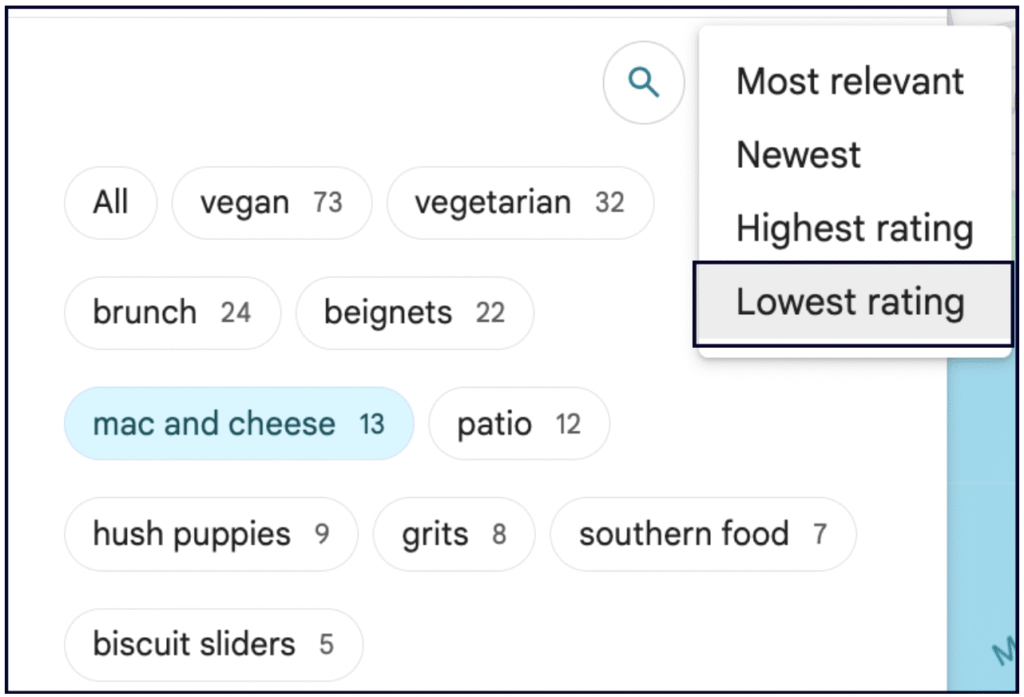
You can also sort the entire body of reviews to see those with the lowest rating. This can deliver insight into areas where your brand can make a difference with a better offering.
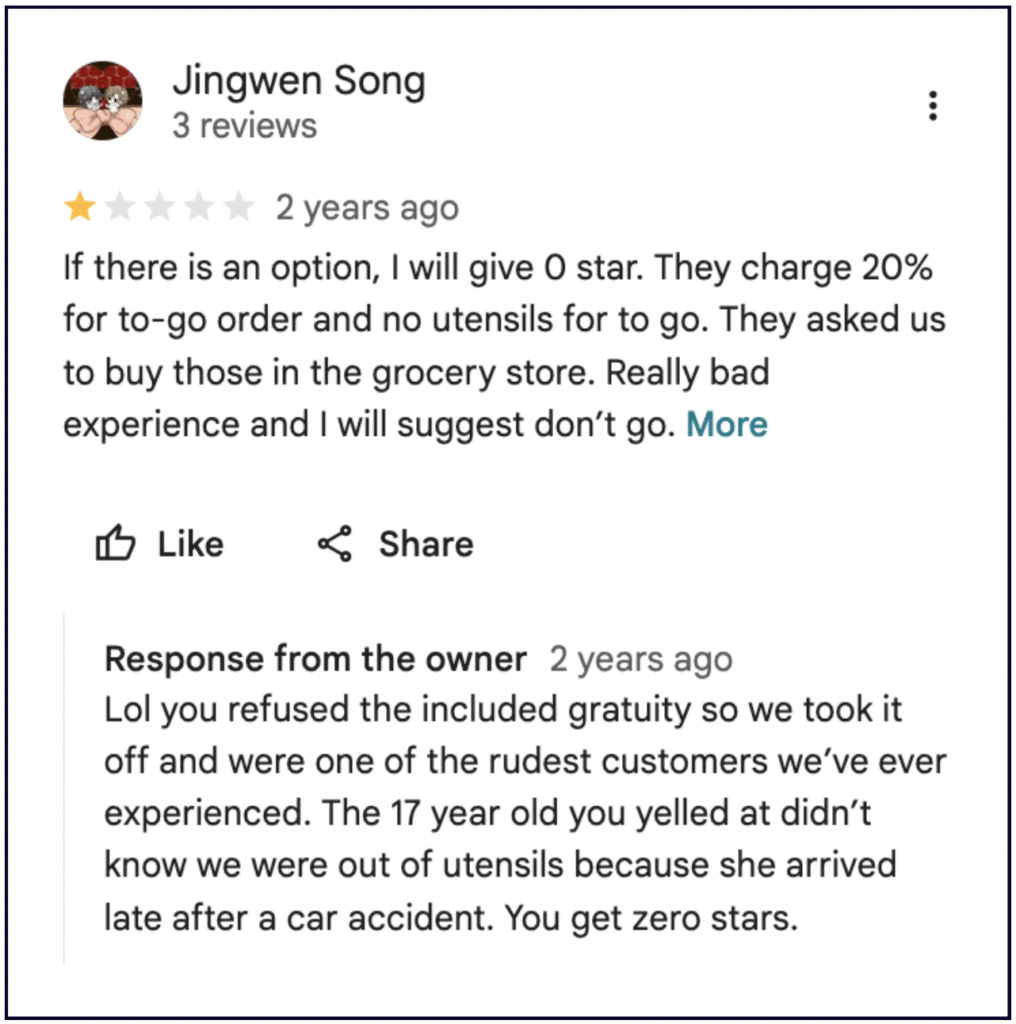
Pay particular attention to any review and response content that indicates poor customer service (see above). Regardless of industry, good customer service is always in demand, and can be the top competitive-difference-maker in many scenarios.
💡 Pro tip: Don’t just document what customers say they want, but how customers say what they want. Regional language varies widely across countries like the U.S. and your website content needs to reflect how local people speak about the products and services you offer. If you didn’t grow up in the community you serve, pay special attention to any regional vocabulary that’s new to you so that you can reflect it in your website content.
In step 1, you guessed at the top keyword phrase locals might use in searching for a business like yours, and you took notes on how your competitors are featuring keywords on their websites. In step 2, you added to your documentation by polls, surveys, and social listening. Now, you’re ready to do a keyword research session to further formalize your knowledge of how the public searches for offerings like yours.
There are multiple free keyword research tools on the market today. These include free ones, like Google’s Keyword Suggestion Tool and Google Trends for tracking how searcher behavior is trending at the moment for specific search phrases. There are also many third-party tools that offer free trials or free versions, like SEMrush’s Keyword Magic Tool, that will generate a list of keyword combinations for you from a single seed keyword, or Moz’s general Keyword Explorer Tool. There are also good question-oriented keyword tools like AnswerThePublic and Also Asked.
There is no shortage of options, and most tools work similarly by letting you input a variety of keyword phrases and then giving you a set of evaluations of the search volume, popularity/difficulty of each phrase, estimated click-though rate for each phrase, and other metrics which are meant to help you determine demand and create content that matches what the public is searching for.
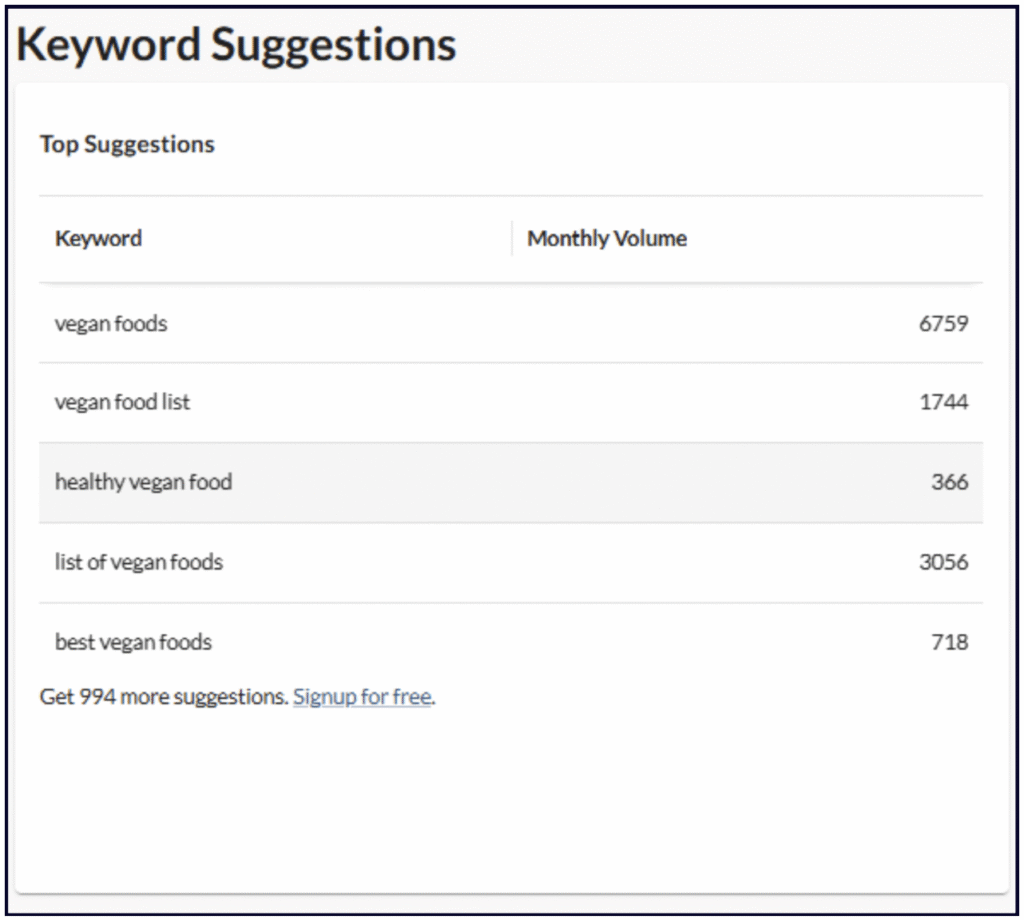
Take advantage of any free test drives offered by keyword research tools that look reputable so that you can find one that makes sense to you and your team. However, it’s important to bear one hard fact of life in mind when looking at the results:
⚠️ Keyword research tools do not accurately report true local search volume for most towns and cities.
In the above screenshot from Moz’s free Keyword Explorer Tool, we see exciting monthly search volumes when we look up a broad term like vegan food.
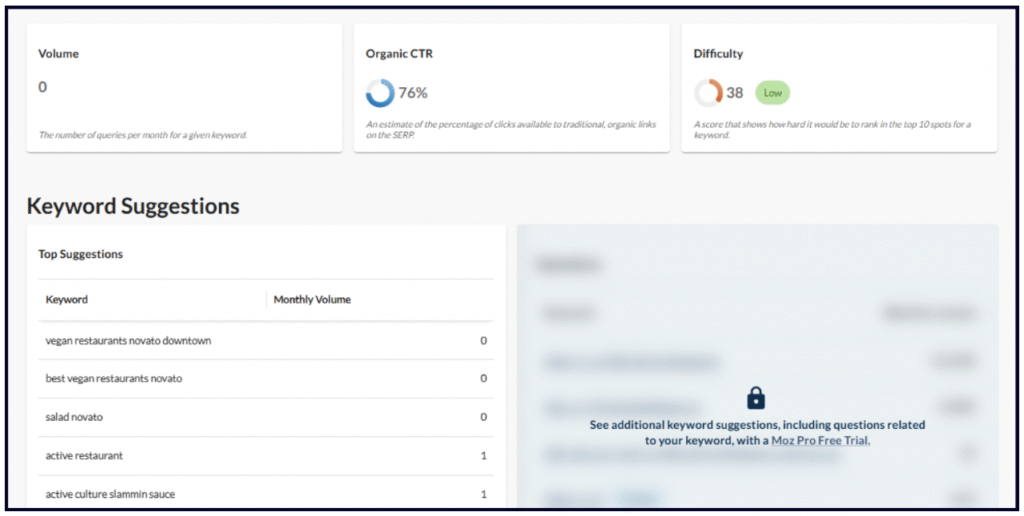
However, when we refine our search to try to find out something like how many people are looking for vegan restaurants in a small California city like Novato, keyword research tools will erroneously report that there is zero search volume for this term.
As you go about the work of optimizing your website, don’t be discouraged by the zeros of keyword research tools when looking for local insight. These results typically mean that the tools lack information about your community’s search behavior, and even if you live in a large city, you should regard reported volumes as estimates rather than hard numbers when you modify your keyword phrases with geographic terms.
Because keyword research tools tend to lack complete information about hyperlocal searches (like vegan restaurants in Novato), you are better off doing non-geo modified searches in these products to get a sense of the general popularity of broader terms, and then adding location terms back in when you are actually writing content and optimizing website pages.
This is not a perfect scenario, and it’s why local businesses need to strengthen their research by surveying their own communities and evaluating their nearby competitors. In a nutshell, keyword research tools are really helpful if you’re trying to determine something like whether to optimize a page for vegan restaurant or vegan deli, but they are not particularly helpful in finding out which version is most searched by your own neighbors. Fortunately, because you serve the public face-to-face, you have the chance to ask your own customers via in-person conversations and surveys.
In addition to using trusted keyword research tools, there are two other tactics that are helpful for discovering alternate ways in which the public searches for goods, services, and features like yours.
To see the first, go to Google’s search bar and start typing in a phrase you’ve discovered via your research:
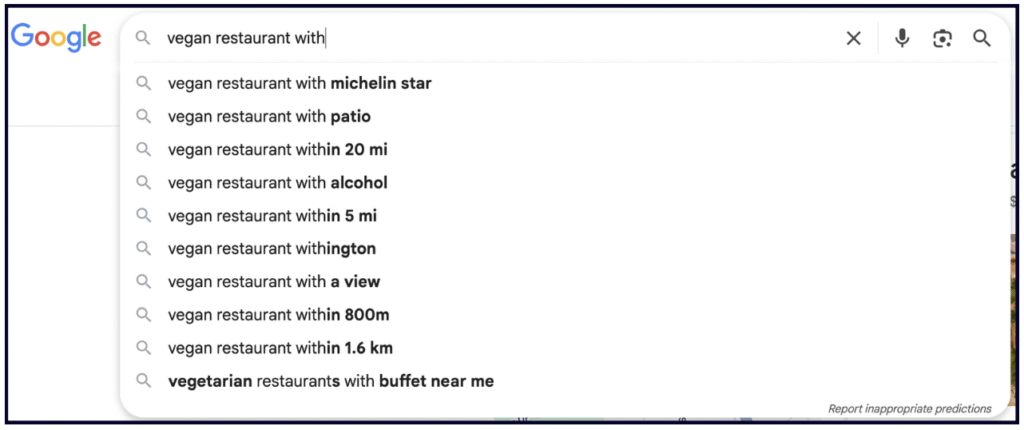
Google will autocomplete your partial search with suggested searches others are performing. Here, our search has turned up that lots of people are adding mileage specifications to their searches, and that some are looking for vegan restaurants with bars, alcohol, and a Michelin star. Google autocomplete can further add to the list of terms for which you can optimize your website.
In addition to Google’s autocomplete behavior, do a search and look for their “People also search for” feature in the organic results:
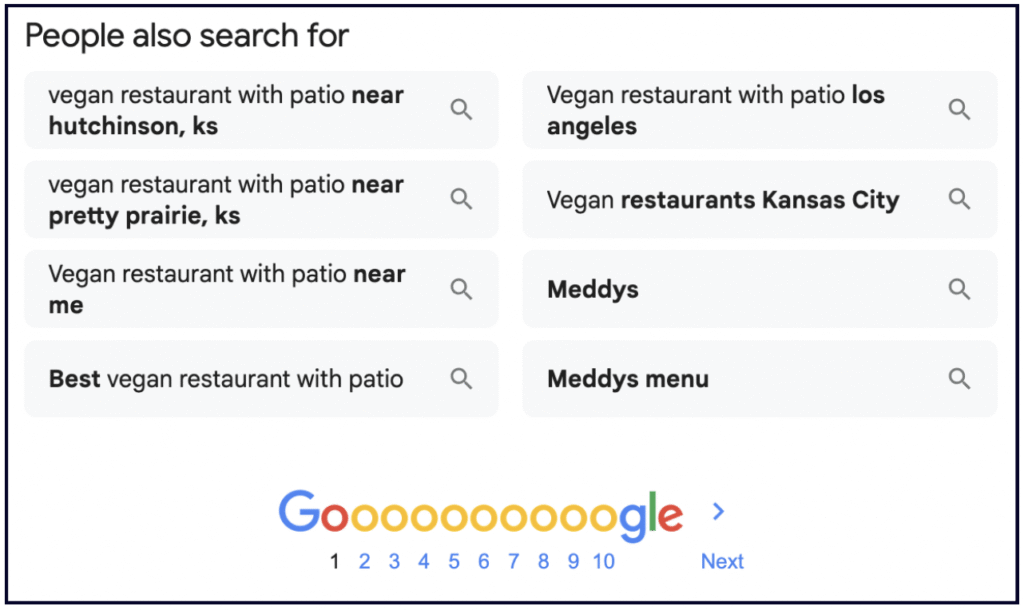
Like the suggestions in the search box, this feature can help you find additional popular search phrases that you can match with the content you develop on your website.
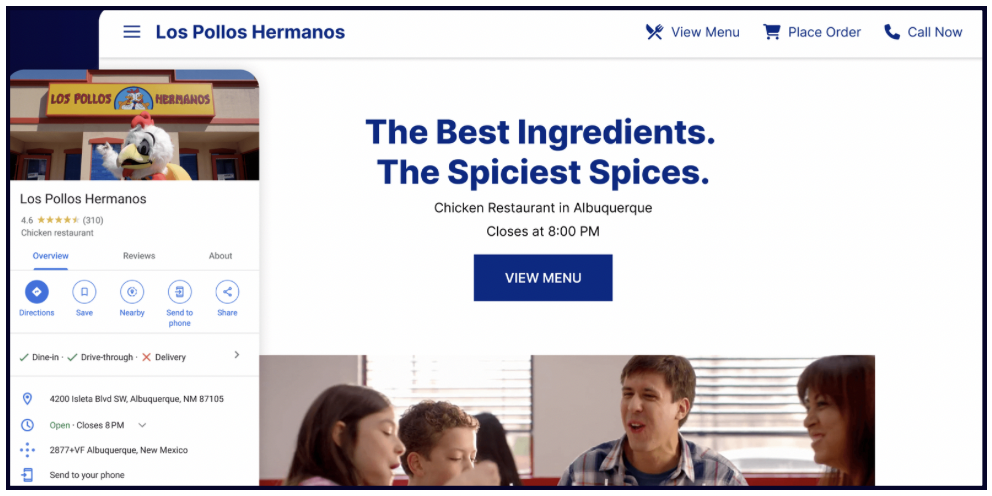
If your small business startup’s budget is extremely limited, and you cannot yet afford the fees of a professional content management system for building out a multi-page site, it’s quite possible to start out with a one-page website like the one shown above, created with Whitespark’s GBP Website Replacement product for $1 a month.
This offering was developed when Google shut down its free one-page website product. While a single page site is unlikely to be enough to make your business a top competitor in a busy market, it is at least a launchpad for publishing your business name, contact information, basic business information, and a call-to-action, and it will give you a URL to link to from your Google Business Profile.
Ideally, however, your business has set aside a reasonable budget for purchasing a domain and getting hosting and a content management system from a platform like Wix, Shopify, or a similar trusted brand.
While each small business is unique, it’s good to have a list of minimum pages you need to go live with at launch, and to see examples of other brands that are doing a great job and a not-so-great job. For most local brands, the starter list of 3 basic pages looks like this:
At minimum, your small business’ homepage should include:
Not-so-good example:
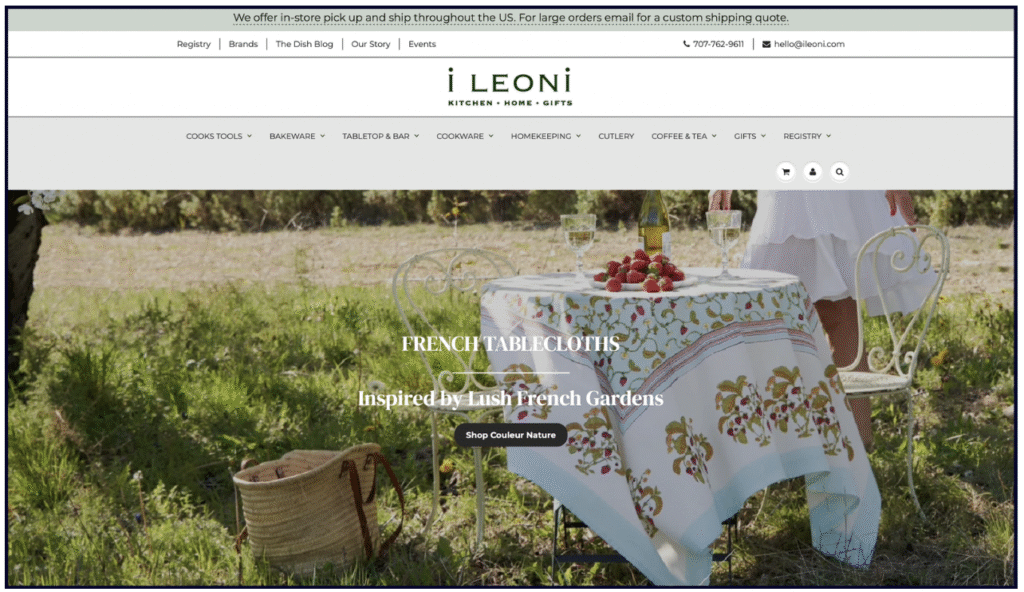
What’s wrong? At a glance, my first impression of this homepage looks okay until I realize that it gives no indication of where this business is located. That’s a huge mistake, and one that could be easily fixed with a USP near the logo reading “Petaluma’s Largest Kitchen and Home Goods Store” or something similar, and the complete address of the business listed right next to the phone number.
Good example:
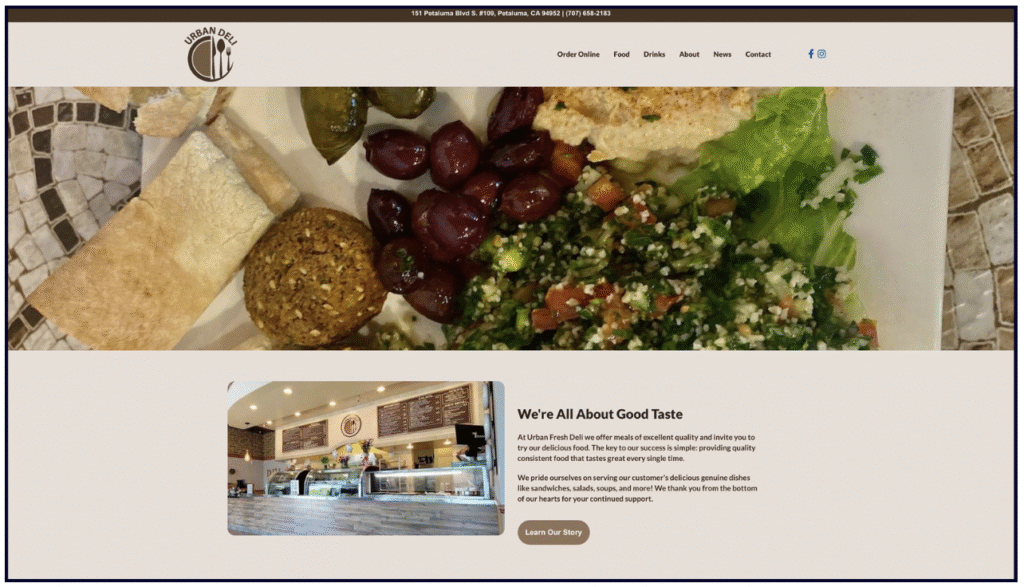
A good contact page should display information that matches your name, address, and phone number on your legal business documents and on your Google Business Profile. A contact page for a single-location small business should include:
Not-so-good example:

Sadly, this SMB website for a restaurant has no Contact page at all, no photos to help the customer find it on the street, no map, no driving directions, no social media links, no CTA, and almost nothing to help the public choose it.
Good example:
This landing page for a branch of the REI franchise offers good inspiration for what the contact page for your single location small business should look like, with lots of helpful information.
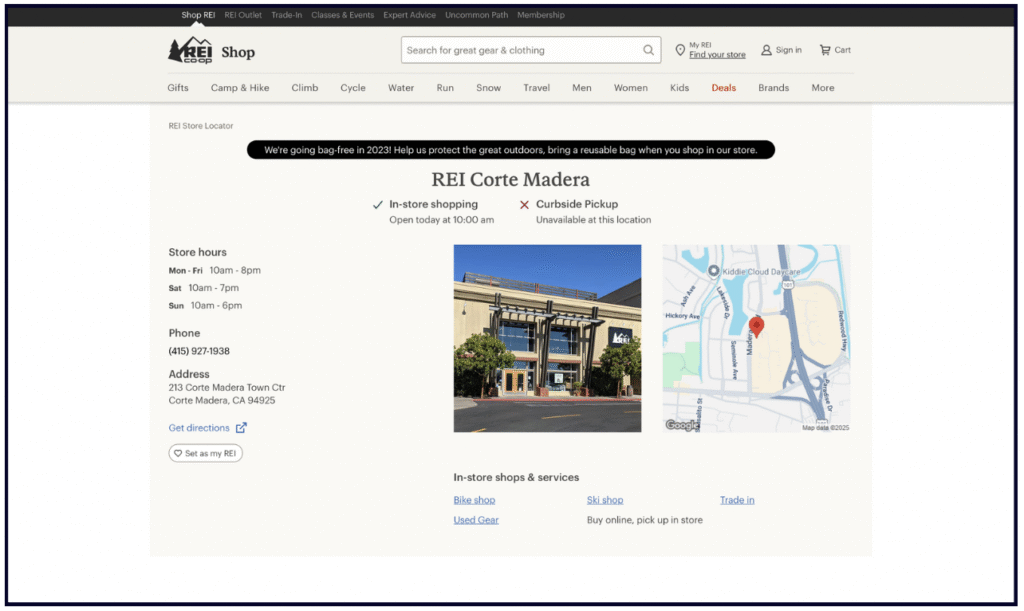
If you’re starting off very small and are having to choose whether to devote time to creating an About page or a Reviews/Testimonials page, choose the latter. 60% of consumers trust what customers say about a business over what the business says about itself. Before you ask for reviews or testimonials, read the following warnings:
Fraudulent review practices can result in lawsuits and legal penalties as well as negative local SEO outcomes. Read Google’s prohibited and restricted content guidelines and know the truth-in-advertising laws of your nation so that you don’t fall afoul of rules and codes. Reviews should always stem from real customers and honestly represent first-hand experiences with your business.
The not-so-good example here would be any website that lacks a Reviews/Testimonials page (there are lots of these). Instead, take serious inspiration from the example of this jewelry store, which not only highlights third-party reviews from sites like Google, but has an amazing gallery of handwritten thank you cards from its delighted customers. A strong page of this kind will convey trustworthiness, legitimacy, and popularity of the business within its community.
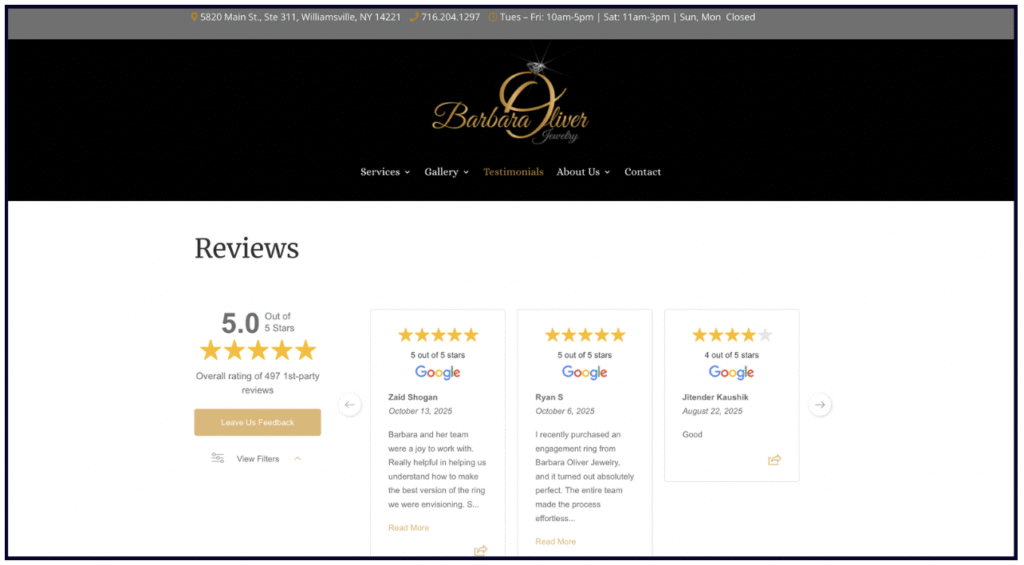
Once you have developed your Home Page, Contact Page, and Reviews/Testimonials Page, you are ready to start putting all of your market, consumer, and keyword research into practice via the development and optimization of additional pages.
Each business will be unique. Look for the pages that are relevant to your business model and community in the following list, and make use of our pro tips for each variety:

Some small businesses have a fascinating story or mission to share, like this Indigenous-owned cafe in the San Francisco Bay Area. Your About/Mission page can excite the public about choosing you, but in nearly all cases, small business owners should take care to incorporate the customer into their story.
Don’t just talk about why you like your business – explain why you’ve built your business so that customers will like it and find it useful. To see a great example of this, look at this page from the National Park Service about one of their properties, the Point Reyes National Seashore (shown above).
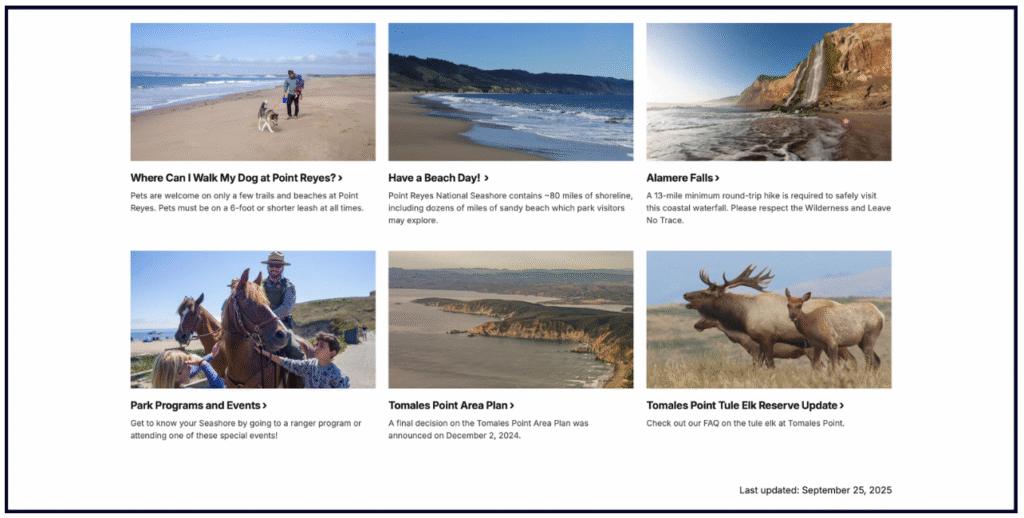
What I love about this page is how it has been broken into sections intended to empower visitors to interact with this local attraction. It answers questions from the public, like “where can I hike?”, “where can I walk my dog?”, “when can I see whales?”, “can I get a map at the visitors center?”, or “what are the best beaches to visit?”
Try to imagine your business as though it were a major destination, and use your About page not just to describe your business, but to engage people with actionable elements of it that they can enjoy if they choose to visit or book your services.
If you’re struggling to come up with ideas beyond a simple statement of purpose for this page on your site, you can turn this page into a core asset by incorporating some or all of the following elements:
Take pride in telling your story, but gear everything towards the customer with an eye to persuading them that your business is the right choice for their needs. You’ll find some good inspiration for telling a vibrant story on this independently-owned grocery store’s About page.

Your small business can begin to earn visibility in the organic results by investing in product pages. These typically fall into 3 categories:
1. If you’re running something like a small grocery store, it’s probably not practical or helpful to the customer to list every single item in your inventory.
Instead, you might create “shelfie” or “aisle” pages that showcase your produce section, dry goods section, deli counter, etc. Another example might be a toy store that isn’t yet ready to list every toy it stocks, but can create product category pages for major brands like LEGO, Fisher-Price, and Hot Wheels.
2. A step-up from this is to create a unique page for each main product sold.
Strong product pages feature product names, images, descriptions, specifications, availability information, and reviews.
3. The ultimate solution is to have e-commerce on the site, with a unique page for each product and shopping cart functionality, plus excellent photos, text descriptions, specifications, real-time inventory information, and reviews.
Look at a product page for almost anything on Amazon.com and you’ll have the best idea of all the features that can be incorporated into pages designed to make it easy to find and shop inventory.
If you’re struggling to think of features to include on your product pages, I recommend checking out this listing for a duffle bag on Patagonia. This single page features:
As with your About page, make every effort to center the customer in featuring any product. Explain why the product is a good choice for them that will meet their needs, solve their problems, and improve their life.
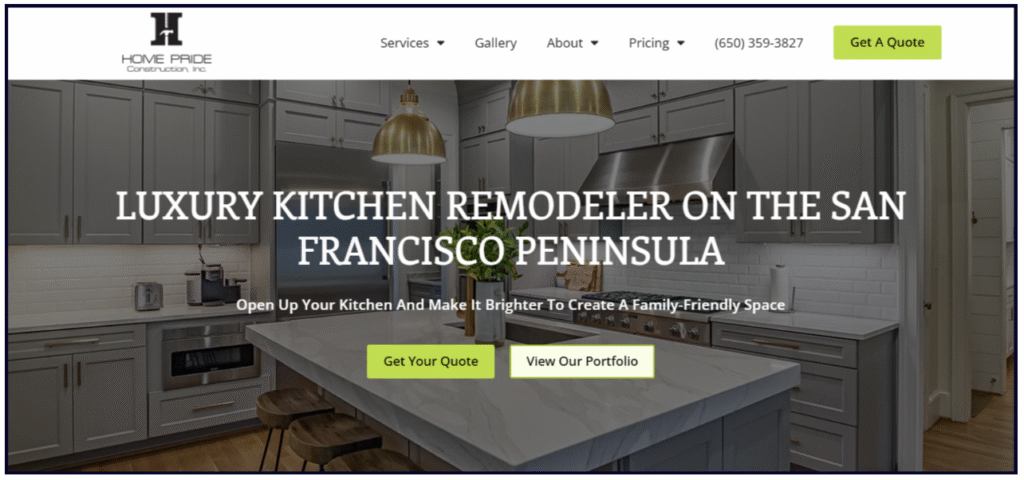
By creating a unique, engaging, and optimized page for each main service offered by your business, you’ll increase your chances of being brought up as a result for local searchers. Here’s a classic example of the kitchen remodeling page of a general contractor who offers multiple design and construction services. I liked this page as soon as I saw that its main heading included a geographic modifier (San Francisco Peninsula), which immediately signaled the service area in which the service is available, and that the subheading is completely geared towards the aspirations of the customer, stating, “Open up your kitchen and make it brighter to create a family-friendly space.” Keyword and consumer research is evident in a statement like this. Other great features of this page include:
Take inspiration from this page and consider other elements you might add to your own Service pages to make them the best in your market, including:
While some small business models are so simple that they don’t require the development of additional landing pages, more complex models may require one or more of the following four types of landing pages to achieve maximum visibility in search engine results:
If your small business has opened more than one branch, you should have a unique page for each location. Each location landing page should feature:
Based on your business model, community needs, and industry, there are many other elements you might add to strengthen the usefulness of your location landing pages. Think of them as the next best thing to the customer speaking to one of your expert staff members in person. Anticipate and answer every question a customer might ask before choosing the business.
The Google Business Profile for the branch can then be linked to this landing page, creating a user-friendly experience for searchers who move effortlessly from the location’s local business listing to the right page on the company’s website.
When a business serves customers at their locations instead of at its own premises, creating landing pages for each main town or city the business serves will increase its opportunities to be seen as a relevant result by search engines. Though Google makes some exceptions to this for large brands, your service area landing pages should not feature location information that overlaps with any of your other service areas, and each service area should extend no further than about 2 hours’ driving time. Your service areas should match the service radius information on your Google Business Profiles. Strong service area landing pages include:
The main FAQ that comes up in the context of developing high-quality service area landing pages is how to differentiate them when the same service is being offered across multiple towns and cities. This question matters because no business wants to get a reputation with Google for publishing large volumes of thin, duplicate or near-duplicate content. Excellent ways to differentiate service area landing pages from one another include publishing:
Location landing pages and service area landing pages can feature a lot of the same types of content. The main difference is that the former emphasizes the physical address of the business, while the latter focuses on how the business comes to the customer.
Even though a business is small, it may have multiple practitioners who directly serve the public. Examples of a multi-practitioner business include a dental practice with three dentists, or a legal firm with four lawyers. In such cases, the business can broaden its opportunities to rank well for a variety of terms by building out a unique landing page for each practitioner. Strong practitioner pages include:
If your keyword research has turned up a wide variety of search terms related to your business, practitioner landing pages can be a good place to incorporate them by writing about the specialties and expertise of a specific partner within the practice. The Google Business Profile for the practitioner can then be linked to this landing page, creating a frictionless experience for searchers who move effortlessly from the practitioner’s local business listing to their page on the website.
Some small businesses may have multiple public-facing departments, each with their own phone number. An example of this would be an independently-owned car dealership with different departments for sales, parts and service. Strong department landing pages include:
If a department meets Google’s eligibility guidelines, it can have its own GBP and can link from its listing to the department page on the website, creating a helpful experience for customers.

Some small businesses (like therapy practices or general contractors) are legally required to display licensing information. Often this is simply included in the header or footer of these websites, but you can also explore building an entire page that showcases:
Apart from legal requirements, however, the best small business websites will feature a customer guarantee page, outlining everything the business promises the customer. Customer service quality will be the main component of your small business’ success (or failure!). Take inspiration from the creative approach of the wildly-successful family-owned business, The Vermont Country Store, who publishes this Customer Bill of Rights as its own page.
✍️ Google’s Quality Raters who evaluate whether their search engine is returning relevant answers to users’ searches are trained to look at trust signals. Elements like clear contact information, clear policies, and proofs of the accessibility and accountability of your business matter.
In addition to creating some or all of the above pages, you may be exploring whether your business should also commit to an enhanced publishing plan that might include:
The answer to this question might be “yes” if:
The answer to this question might be “no” if:
Remember that no local business is obliged to publish a blog or create a video channel. Sometimes, it’s just not a good fit for your model or market. These efforts will be best fitted to yield a meaningful return on investment when the business is highly-motivated, well-resourced, and can either fill or create demand for their content in their market.
There’s no shame in determining that your business isn’t currently ready to explore the opportunities of additional multimedia publishing right now. Instead, you can research local and industry publications to discover how you can be their guest, contribute to their content, or become a good news story for their audience.
✍️ A special note: Even if you don’t plan to publish a newsletter at the moment, smart local business owners should come up with a consumer offer that results in the ability to collect customers’ email addresses or text lines. Building up your own database of customers who don’t mind hearing from you occasionally is an important step to opening a communications channel that isn’t dependent on Google, social media, or any other third party platform.
Every page you publish on your small business website will be the best that it can be if it serves two audiences:
Use the findings of your market, consumer, and keyword research across all pages of your site so that your content matches the needs and intents you’ve discovered in your community. This guide has shown you a spectrum of opportunities for turning your site into a customer-centric asset that helps people access your business and all that it offers. Every neighbor your website assists is an important part of the success story of your brand.
While search engine bots and AI scrapers will never be your neighbors, learning to serve them with the technical formats they need to function carries the rewards of being visible to the online public. The perfect small business website complies with the following best practices:
This form or search engine optimization (SEO) makes the most of the opportunities to incorporate the important keyword phrases you’ve discovered into the pages of your website. Key on-page SEO elements for your local business website include:
Title tags

Your website’s content management system (CMS) should have a field labeled “title”, “page title”, or “title tag” for each page you create. In Google’s search engine results, this is typically displayed as the largest clickable element of your listing. The above example reads “Golden Gate Bistro Restaurant in Novato, CA – Golden Gate…”. As you can see, this title tag has been well optimized to include the name of the business and its location, but it’s being cut off at the end.
Current best practices suggest that Google seems to prefer displaying title tags that are 42-46 characters in length, though there is technically no limit to this field. In fact, SEOs are not in uniform agreement about the best way to optimize title tags. Some say you should stick to a rigid length, and others say you should add whatever phrases and keywords you want to each tag, so long as it’s legible, because there’s a good chance Google will rewrite it anyway for display in their results. Sometimes, Google will display your Header 1 (H1) tag in their results, instead of your title tag, and sometimes they’ll simply generate a custom tag if they believe it better matches the intent of the searcher.
At minimum, local businesses should always strive to include a geographic term, like a city name, in every title tag on their website, but avoid the temptation to write title tags that look like a meaningless list of keywords. Title tags not only help search engine bots understand what a page’s contents are about, but they also influence human searchers to click into your page. Title tags are strongly believed to influence organic search engine rankings.
Meta description
In Google’s results, the meta description is typically the second main line in your entry. In the above example, the meta description begins, “Golden Gate Bistro is a top rated barbecue restaurant located in Novato, CA. At Golden Gate Bistro, our goal is to offer our customers authentic BBQ food…”
Current best practices suggest that meta descriptions should be 150-160 characters in length to avoid being overly truncated in the search engine results. However, it’s important to know that Google frequently customizes this line of your entry in their results to more closely match their perceived intent of a searcher.
Because of this, you should make the effort to fill out the “meta description” field for each page when creating it in your website CMS, but be prepared for Google to display something other than what you’ve written in this field.
Powerful meta description tags act like an elevator pitch for the contents of the page. They should be honest and accurate, and persuade searchers that they will find the content that they are looking for if they click through. Meta description tags are not believed to influence organic search engine rankings, but they do influence searcher behavior, and that’s very important.
Page URLs
The URL (webpage address) of each page you create should be optimized with the most important keywords related to that page. Most CMS products will let you create a custom URL for each page. Here is an example of a multi-location business which, unfortunately, has failed to optimize its location landing pages. They simply say, “locations-1”, “locations-2”, etc.

Instead, your URLs should look more like this example, from a multi-location outdoor outfitter, including geographic information:

Here’s another good example from a service area business in which both the service and geographic information have been included in the URL:

URLs provide an important way to signal to search engines that the contents of a page match the intents of specific searchers.
Headers
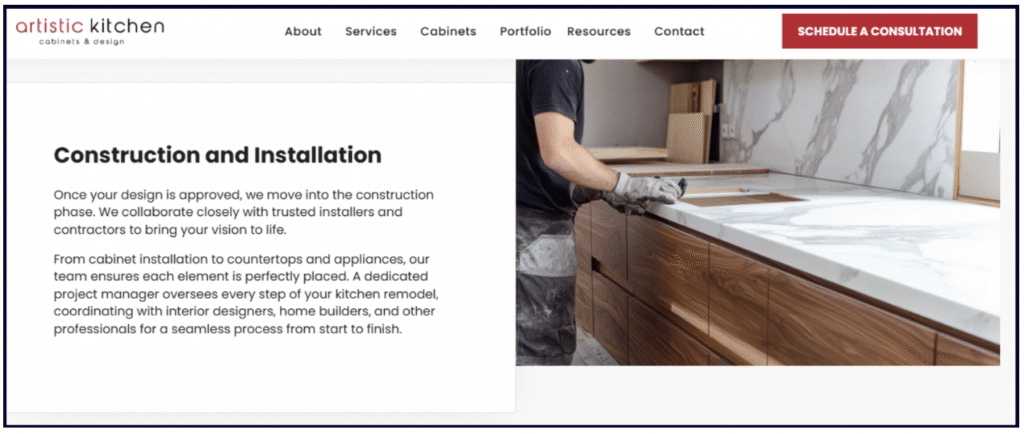
Most CMS products feature the ability to format page content with a variety of headings, such as H1, H2, H3, etc. While the SEO impacts of header tags are debatable in our modern era, headers can create a much better user experience when they break up long form page content into more digestible segments. Look at how headers have been used on this kitchen remodeling site to help readers understand different aspects of the business, such as the consultation process, the design process, the construction process, etc.
Headers are an excellent place to reflect the findings of your keyword and consumer research to strongly signal to website visitors that your business understands their intent and is ready to meet it.
Main body content
The text, photos, videos, and other media that occupy the main body of each page are your main stage for showcasing all that you’ve learned about what customers need and the keywords they use when they search. Take a look at this example of a business doing a great job engaging the customer with an offer to meet their intent to get the perfect birthday cake for someone:

The language is action-oriented, persuasive, and ends with a strong call to action to shop now. However, do you notice anything missing from this section of this page? That’s right – there is no mention of the city this business is located in, or the service area throughout which it can deliver cakes. Carefully vet all pages of your local business website to ensure that you are continuously emphasizing geography. Without this vital information, you cannot depend on search engines or humans understanding where you are or where you serve.
Throughout this guide, we’ve emphasized the big role photography should be playing in the development of your website. Whether your website contains a small or large number of images, you can optimize their filenames to describe image content with the relevant keywords you’ve discovered, but image SEO is a deep dive of its own these days.
Start by familiarizing yourself with Google’s image SEO best practices. Then, spend time studying newer developments like Google’s Cloud Vision API to begin learning about the huge topic of AI image recognition. If visuals play a large part in how consumers choose businesses in your industry, you can gain a competitive advantage by investing in photography that serves emergent image recognition technology.
Your CMS should offer you a field labeled “alt text” each time you upload an image to your site. This is not an SEO element, but is an essential field for website users with visual impairments for low vision. Best practices include keeping alt text to around 125 characters, and concisely describing image contents for visitors who use screen reader programs. Don’t forget to write alt text for call-to-action buttons on your website so that these valued visitors can act on them.
We’ve also highlighted the power of video media to enhance the usefulness of your website. Where possible, videos should feature transcripts so that their contents can be fully understood by search engines.
Navigation menus and internal links

Your website should feature a consistent method of navigation via its main menu (like the one shown above). While menus can contain dropdowns to showcase all your pages, be sure that your most important pages are always visible in the main menu. For small local businesses, the main menu should always include either the Contact page or a set of links to the location landing pages or service area pages (in the case of multi-location or multi-service area businesses). Be sure your menus display and work correctly on both mobile and desktop devices.
In addition to the links in your formal menu, your internal linking practices amongst the various pages of your site need to be carefully considered as part of your SEO strategy. Every time you link from one page of your site to another, it is like a vote for the importance of that page in your overall site architecture. Links of this kind pass “authority” (ranking power) from one to the other.
While this guide is not an exhaustive SEO tutorial, the main concept at play here is that the pages on your site that have accrued the most authority via the links and mentions they’ve earned from third-party publications can pass some of that authority on to other pages of your site. It’s typical for local business home pages to have accrued the most links and mentions, and so linking from the home page to something like a product or services page would tend to pass on the most authority.
The language you use to link from one page to the other (or that third parties use to link to your pages) is widely considered to be a ranking factor. If you’re eager to learn more about organic SEO, read Google’s SEO Starter Guide and then begin digging into current research from major SEO industry publishers.
In addition to complying with on-page SEO best practices, your small business website needs to ensure that technical errors aren’t preventing it from achieving maximum search engine visibility. Google offers this guide to getting started with technical SEO and best practices include:
Each of these elements is its own topic and can take time for your business to perfect, but Google offers this guide to getting started with technical SEO.
✍️ A special word on this to small business owners: Not all website builder programs/CMS systems offer adequate support for each of these factors. In choosing a provider, use the above list to evaluate whether a program you’re considering is up-to-date on technical SEO protocols.
We’ve covered a lot of material in this guide! Sign up below to get your own copy of the handy Small Local Business Website Checklist to aid you in your website publishing process and to remind you to refer back to this guide at different stages of development.
Next step: Now that you’ve familiarized yourself with the work that goes into developing the perfect small business website, you’re ready to move onto Whitespark’s Complete SEO Strategy Guide.
Miriam Ellis is a local SEO columnist and consultant. She has been cited as one of the top five most prolific women writers in the SEO industry. Miriam is also an award-winning fine artist and her work can be seen at MiriamEllis.com.
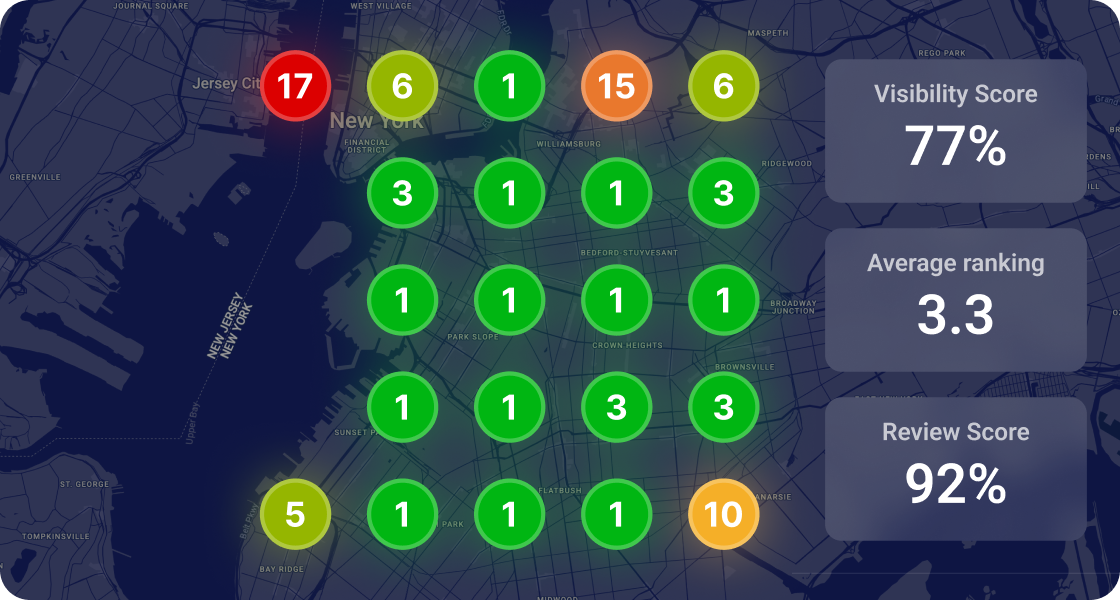

Whitespark provides powerful software and expert services to help businesses and agencies drive more leads through local search.
Founded in 2005 in Edmonton, Alberta, Canada, we initially offered web design and SEO services to local businesses. While we still work closely with many clients locally, we have successfully grown over the past 20 years to support over 100,000 enterprises, agencies, and small businesses globally with our cutting-edge software and services.